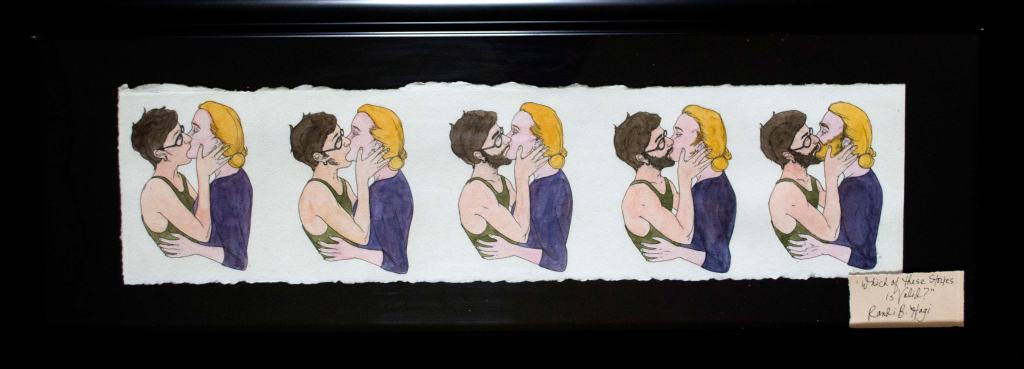Everyone is queer – and that is a relief.
Take the straight, cisgender “standard.” People are born with XY chromosomes, a penis, prostate, and testicles; or the perceived opposite: XX chromosomes, a uterus, vagina, and ovaries. The former is exclusively sexually and emotionally attracted to the latter, and vice versa. Each follows a pre-set, culturally specific pattern of behaviors – for example, the XX-ers being professionally inept, dependent, and emotionally flighty; the XY-ers being competitive, self-assured, and emotionally stunted. Each wears certain clothes, performs certain rituals, and likes certain activities based on their chromosomal dichotomy.
Nobody conforms to those standards, thankfully.
Begin with the basics of biological sex. Already, the paths of possibility fork, twist, and diverge in myriad ways. Babies are born every day with ambiguous genitalia, XY chromosomes matched with vaginas, one X chromosome, Klinefelter’s syndrome, partially- or non-functioning reproductive organs, and every amalgamation imaginable. Any dichotomous system of classification based on genitalia – such as “men” and “women,” is already defunct by virtue of our mammalian bodies.
Take, next, that humans are more than our physical equipment – we are also sex, romance, and attraction. But if there is no clear division between male and female, then any system of classification based on that division – such as “gay” or “straight” – has no basis. What is a “lesbian” relationship when “woman” itself is such a vague term? Even if we play by the exclusive, imperfect game of naming people “men” and “women,” how many of us have truly never felt an itch of attraction or interest towards someone outside our “orientation?” Man-crushes, girl-loves, best friends who function as committed couples – these are inklings, exceptions, and alternatives that are not accepted into our comprehensive narratives of ourselves. Were we to accept them, we again would all blur the lines of straight, or gay, or what have you; which is pretty queer, if you ask me.
As social beings capable of abstract thought, we experience gender societally, aside from our physical equipment. Gender becomes a performance, and a few steps of choreography may in one culture be straight and normative, but in another, queer or offensive. Male friends hold hands in Myanmar, Colombian women kiss each other on the cheek, men wear kilts in London and purses in Colorado and provide childcare in Denmark, women wear pants in China and graduate from universities in Iran and shave their heads in Canada. The lines of external gender expression are so arbitrarily drawn in a miniscule time and space that they are useless in classifying humans. A man crying at a romantic film breaks the American straight “ideal.” A woman being a stay at home mother breaks the classic lesbian feminist stereotype. Every single person is more complex and whole than broken caricatures of gender roles can contain. We’re queerer than that.
Internal gender identity is another beast entirely. We perceive ourselves, our bodies and minds, through the broken lenses of our society’s ideas of gender, nonetheless personalizing them to our own experience. I used to identify as a transman, but now I struggle to even define the word. If “woman” and “man” are meaningless placeholders, then what does it mean to transition from one to the other? I know a few things. I have a vagina. I relate to aspects of what is deemed “masculine” culture in 2015 America. I find examples of strength, wisdom, creation, and inspiration in the people around me with all manner of biological sex and gender expression. What else can I say? We as people can learn to inhabit and love our wide array of bodies and their wide array of sexual equipment and their wide array of connections to other humans. Beyond that, any attributes ascribed to our equipment become inaccurate at best and psychologically repressive at worst. When even internal gender identities cannot define us, we’re getting hella queer.
The bottom line is that our bodies and minds and relationships are far too diverse, beautiful, multi-faceted, and flexible to accurately portray any confining terms for them, straight or otherwise. We can be parents, siblings, lovers, actors, writers, farmers, musicians, engineers, nurses, vagabonds – but trying to assign ourselves culturally-laden monikers extrapolated from our sex chromosomes is futile. Man, woman, dyke, gay, hetero, trans – these are facades. The self-aware person is necessarily queer because they are too much – too many experiences, feelings, and histories – to fit any limiting narrative, especially one as two-dimensional and unimaginative as the straight, cisgender model. Were everyone to accept this multi-colored, many-textured queerness about themselves being themselves – once everyone is queer – then the term itself becomes unnecessary, and a wider recognition of humanity takes its place. I look forward to the day that I am merely human.
— Randi B. Hagi
